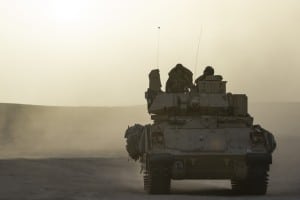The Army has canceled its current solicitation effort for the Optionally Manned Fighting Vehicle (OMFV) with a plan to evaluate and revise the program’s requirements before restarting the competition in the future, officials told reporters on Thursday.
Bruce Jette, the Army’s top acquisition official, said there are no finalized details on when the acquisition effort for OMFV will begin again or how this will affect the targeted date to field the first vehicles in 2026.

“Based on feedback and proposals received from industry, we have determined that it is necessary to revisit the requirements, acquisition strategy and schedule before moving forward,” Jette said. “The Army asked for a great deal of capability on a very aggressive schedule. And despite an unprecedented number of industry days and engagements, to include a draft request for proposal over the course of nearly two years, all of which helped industry shape the competition, it is clear a combination of requirements overwhelmed industry’s ability to respond within the Army’s timeframe.”
OMFV, the Army’s program to replace its Bradley fighting vehicles, has faced scrutiny after the service accepted a single bid sample, an offering from General Dynamics [GD], for the program’s prototype phase.
GD said it “does not have anything to release at this time” regarding the Army’s decision.
The Army also disqualified an offering from Germany’s Rheinmetall, in partnership with Raytheon [RTN], after the team missed the deadline to submit their prototype proposal (Defense Daily, Oct. 14).
Officials declined to offer details on specific vendors’ challenges to meet the OMFV requirements, while Jette noted that one vendor had compliance issues with delivery while a second vendor “had difficulty meeting response issues” and fulfilling requirements.
“We will be pressing forward after revision,” Jette said. “This is not a failed program. This a continuing program.”
Gen. Mike Murray, head of Army Futures Command, called the decision a “tactical pause” and said the prototype effort up until this point has been an opportunity for the Army to learn how the program must be revised moving forward.
“The need for this ground combat capability is very real. It is absolutely imperative that we get this right for our soldiers,” Murray told reporters. “We said from the beginning, not everything was going to be successful the first time around. Most importantly, we would do [the prototyping] early and then we would absolutely learn from the experience and apply it forward. That’s what we’re committed to doing.”
Jette said the Army emphasized increasing the number of industry engagements with OMFV to understand industry’s technological capacity to deliver the vehicle, adding that it became clear the program needed to be revised after there were challenges meeting the full range of next-generation requirements.
“We got as much feedback as we could to draft up the requirements document, with industry’s input,” Jette said. “This gave us a great deal of clarity on understanding what truly is doable within the technologies that we had available from the different corporations, both primes and subs. By going down this path, we’ll be able to get an even more refined view of what can be achieved on what time schedule.”
Officials acknowledged that, after starting with around 11 vendors interested in the program, the Army noticed the competition paring down as program moved toward prototype solicitation.
Several competitors, including BAE Systems and SAIC [SAIC], decided to sit out of the OMFV competition after first expressing interest in going after the program.
Jette said this decision differs from previous modernization failures, such as Future Combat Systems and the RAH-66 Comanche helicopter, which spent billions before being canceled while the Army only invested a much smaller amount in OMFV development before deciding to re-evaluate its approach.
“A good bit of the technology development that was part of this assessment is still totally recoverable,” Jette said.